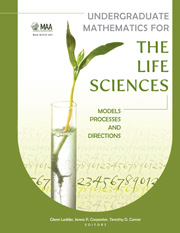General Introduction
Summary
The mathematics curriculum as we know it grew out of the mathematical needs of physical science. We start with a full course in calculus, which requires three semesters at most institutions. This is followed by courses in linear algebra, differential equations, and calculus-based probability and statistics in some order. The latter subjects are the ones with the broadest applications in biology, along with several discrete topics that do not occupy a place in the physics-based mathematics curriculum. Biological applications in these courses have been rare until recently, but many authors are now incorporating biological examples. There are some books in these traditional areas for life science students, but there is no consensus mathematics curriculum for life science.
The standard biology curriculum includes very little mathematics, in spite of the development, beginning in the 1920s, of several important mathematical models for biology. The typical curriculum for biology majors includes just one course in calculus and one in non-calculus-based statistics, and anything beyond two courses is rare.
The result of the gap between the extensive mathematics background that is beneficial to biologists and the minimal mathematics background biology students acquire in their courses is an undergraduate education in biology with very little quantitative content. Mathematics could be incorporated into biology courses such as genetics and ecology, but this is difficult unless the biologist who teaches the course can count on students with the necessary mathematics background.
- Type
- Chapter
- Information
- Undergraduate Mathematics for the Life SciencesModels, Processes, and Directions, pp. xvii - xviiiPublisher: Mathematical Association of AmericaPrint publication year: 2013



